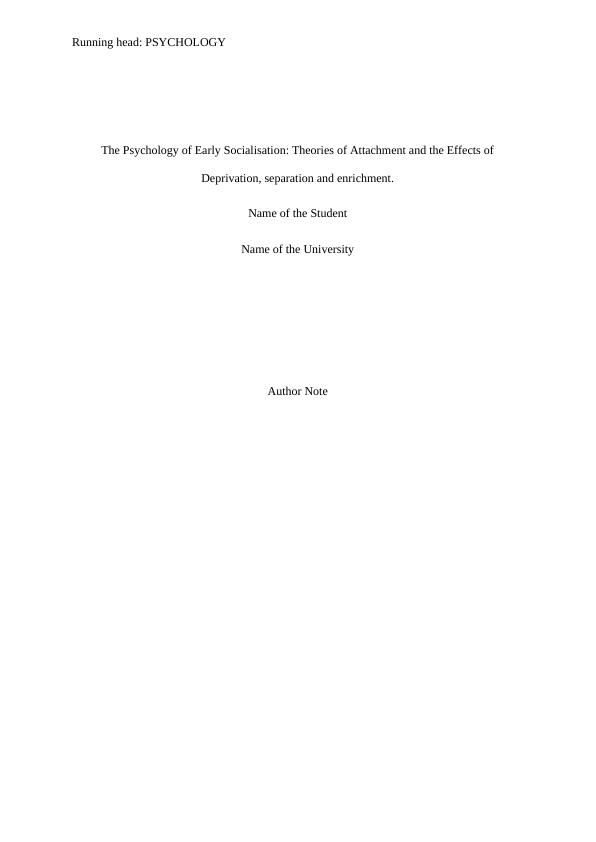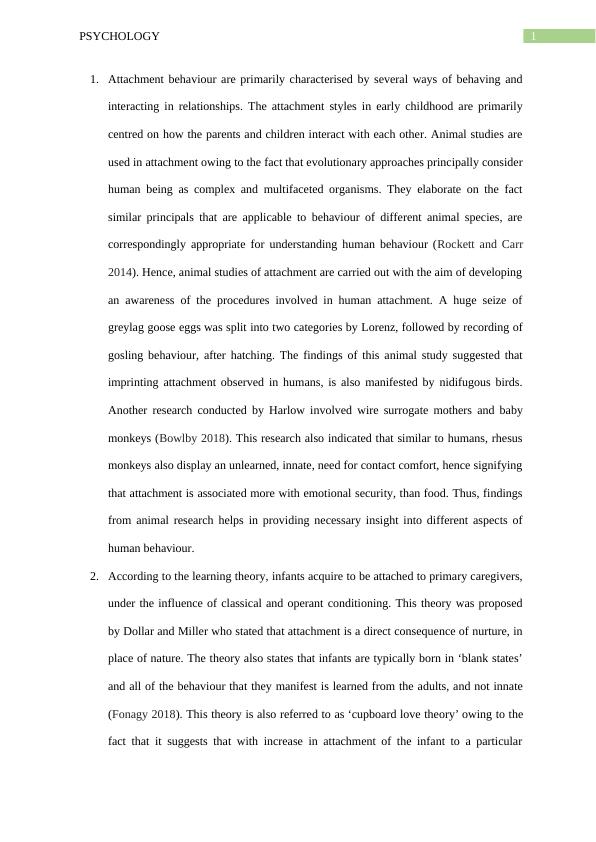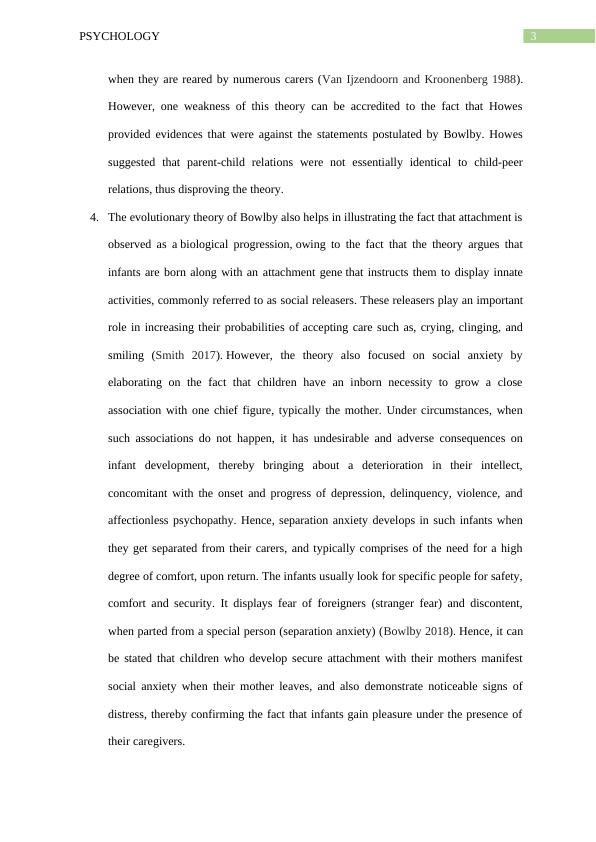The Psychology of Early Socialisation: Theories of Attachment and the Effects of Deprivation, Separation and Enrichment
Added on 2023-04-23
13 Pages3647 Words66 Views
Running head: PSYCHOLOGY
The Psychology of Early Socialisation: Theories of Attachment and the Effects of
Deprivation, separation and enrichment.
Name of the Student
Name of the University
Author Note
The Psychology of Early Socialisation: Theories of Attachment and the Effects of
Deprivation, separation and enrichment.
Name of the Student
Name of the University
Author Note

1PSYCHOLOGY
1. Attachment behaviour are primarily characterised by several ways of behaving and
interacting in relationships. The attachment styles in early childhood are primarily
centred on how the parents and children interact with each other. Animal studies are
used in attachment owing to the fact that evolutionary approaches principally consider
human being as complex and multifaceted organisms. They elaborate on the fact
similar principals that are applicable to behaviour of different animal species, are
correspondingly appropriate for understanding human behaviour (Rockett and Carr
2014). Hence, animal studies of attachment are carried out with the aim of developing
an awareness of the procedures involved in human attachment. A huge seize of
greylag goose eggs was split into two categories by Lorenz, followed by recording of
gosling behaviour, after hatching. The findings of this animal study suggested that
imprinting attachment observed in humans, is also manifested by nidifugous birds.
Another research conducted by Harlow involved wire surrogate mothers and baby
monkeys (Bowlby 2018). This research also indicated that similar to humans, rhesus
monkeys also display an unlearned, innate, need for contact comfort, hence signifying
that attachment is associated more with emotional security, than food. Thus, findings
from animal research helps in providing necessary insight into different aspects of
human behaviour.
2. According to the learning theory, infants acquire to be attached to primary caregivers,
under the influence of classical and operant conditioning. This theory was proposed
by Dollar and Miller who stated that attachment is a direct consequence of nurture, in
place of nature. The theory also states that infants are typically born in ‘blank states’
and all of the behaviour that they manifest is learned from the adults, and not innate
(Fonagy 2018). This theory is also referred to as ‘cupboard love theory’ owing to the
fact that it suggests that with increase in attachment of the infant to a particular
1. Attachment behaviour are primarily characterised by several ways of behaving and
interacting in relationships. The attachment styles in early childhood are primarily
centred on how the parents and children interact with each other. Animal studies are
used in attachment owing to the fact that evolutionary approaches principally consider
human being as complex and multifaceted organisms. They elaborate on the fact
similar principals that are applicable to behaviour of different animal species, are
correspondingly appropriate for understanding human behaviour (Rockett and Carr
2014). Hence, animal studies of attachment are carried out with the aim of developing
an awareness of the procedures involved in human attachment. A huge seize of
greylag goose eggs was split into two categories by Lorenz, followed by recording of
gosling behaviour, after hatching. The findings of this animal study suggested that
imprinting attachment observed in humans, is also manifested by nidifugous birds.
Another research conducted by Harlow involved wire surrogate mothers and baby
monkeys (Bowlby 2018). This research also indicated that similar to humans, rhesus
monkeys also display an unlearned, innate, need for contact comfort, hence signifying
that attachment is associated more with emotional security, than food. Thus, findings
from animal research helps in providing necessary insight into different aspects of
human behaviour.
2. According to the learning theory, infants acquire to be attached to primary caregivers,
under the influence of classical and operant conditioning. This theory was proposed
by Dollar and Miller who stated that attachment is a direct consequence of nurture, in
place of nature. The theory also states that infants are typically born in ‘blank states’
and all of the behaviour that they manifest is learned from the adults, and not innate
(Fonagy 2018). This theory is also referred to as ‘cupboard love theory’ owing to the
fact that it suggests that with increase in attachment of the infant to a particular

2PSYCHOLOGY
caregiver, the former learns that the guardian or caregiver has the capability of
meeting their nutritional and physiological needs. This makes the infants become
more attached to caregivers, who provide them with necessary food. The importance
of the theory can be accredited to the fact that it focuses on classical condition,
whereby a child learns to form associations with the caregivers, with the immediate
needs of feeding being met, which in turn results in the development of an attachment.
One major strength of this theory is that it provides exhaustive explanation on the
mechanism of attachment formation (Holmes 2014). However, there are several
psychological studies that hint at the fact that attachments developed between
caregivers and infants are not merely controlled by feeding needs.
3. Bowlby’s monotropic theory of attachment is occasionally referred to as
an evolutionary theory. The theory suggests that human phenomena and behaviour
can be elucidated through the procedure of natural selection. Characters which
presented the ancestors an existence or reproductive advantage over other animals, in
the environment of evolutionary adaptation (EEA), are generally passed on to their
offspring, and as a consequence last to exist and multiply (Goldberg 2014). The
theory also stated that attachment is a crucial adaptive superiority that has progressed
to intensify the chance of existence through proximity-seeking conduct. Furthermore,
the theory also illustrated that infants need a qualitatively exceptional relationship to
mature and progress an internal functioning model, concomitant with emotional
maturity. According to Holmes (2014) this distinct bond is referred to as the
monotropic bond of attachment, and has been found imperative in maintaining close
proximity between an infant and the parent, thus offering the infant adequate
opportunities for development of skills. One major strength of this theory is that it
helps in gaining an insight into the fact that infants develop primary attachment, even
caregiver, the former learns that the guardian or caregiver has the capability of
meeting their nutritional and physiological needs. This makes the infants become
more attached to caregivers, who provide them with necessary food. The importance
of the theory can be accredited to the fact that it focuses on classical condition,
whereby a child learns to form associations with the caregivers, with the immediate
needs of feeding being met, which in turn results in the development of an attachment.
One major strength of this theory is that it provides exhaustive explanation on the
mechanism of attachment formation (Holmes 2014). However, there are several
psychological studies that hint at the fact that attachments developed between
caregivers and infants are not merely controlled by feeding needs.
3. Bowlby’s monotropic theory of attachment is occasionally referred to as
an evolutionary theory. The theory suggests that human phenomena and behaviour
can be elucidated through the procedure of natural selection. Characters which
presented the ancestors an existence or reproductive advantage over other animals, in
the environment of evolutionary adaptation (EEA), are generally passed on to their
offspring, and as a consequence last to exist and multiply (Goldberg 2014). The
theory also stated that attachment is a crucial adaptive superiority that has progressed
to intensify the chance of existence through proximity-seeking conduct. Furthermore,
the theory also illustrated that infants need a qualitatively exceptional relationship to
mature and progress an internal functioning model, concomitant with emotional
maturity. According to Holmes (2014) this distinct bond is referred to as the
monotropic bond of attachment, and has been found imperative in maintaining close
proximity between an infant and the parent, thus offering the infant adequate
opportunities for development of skills. One major strength of this theory is that it
helps in gaining an insight into the fact that infants develop primary attachment, even

3PSYCHOLOGY
when they are reared by numerous carers (Van Ijzendoorn and Kroonenberg 1988).
However, one weakness of this theory can be accredited to the fact that Howes
provided evidences that were against the statements postulated by Bowlby. Howes
suggested that parent-child relations were not essentially identical to child-peer
relations, thus disproving the theory.
4. The evolutionary theory of Bowlby also helps in illustrating the fact that attachment is
observed as a biological progression, owing to the fact that the theory argues that
infants are born along with an attachment gene that instructs them to display innate
activities, commonly referred to as social releasers. These releasers play an important
role in increasing their probabilities of accepting care such as, crying, clinging, and
smiling (Smith 2017). However, the theory also focused on social anxiety by
elaborating on the fact that children have an inborn necessity to grow a close
association with one chief figure, typically the mother. Under circumstances, when
such associations do not happen, it has undesirable and adverse consequences on
infant development, thereby bringing about a deterioration in their intellect,
concomitant with the onset and progress of depression, delinquency, violence, and
affectionless psychopathy. Hence, separation anxiety develops in such infants when
they get separated from their carers, and typically comprises of the need for a high
degree of comfort, upon return. The infants usually look for specific people for safety,
comfort and security. It displays fear of foreigners (stranger fear) and discontent,
when parted from a special person (separation anxiety) (Bowlby 2018). Hence, it can
be stated that children who develop secure attachment with their mothers manifest
social anxiety when their mother leaves, and also demonstrate noticeable signs of
distress, thereby confirming the fact that infants gain pleasure under the presence of
their caregivers.
when they are reared by numerous carers (Van Ijzendoorn and Kroonenberg 1988).
However, one weakness of this theory can be accredited to the fact that Howes
provided evidences that were against the statements postulated by Bowlby. Howes
suggested that parent-child relations were not essentially identical to child-peer
relations, thus disproving the theory.
4. The evolutionary theory of Bowlby also helps in illustrating the fact that attachment is
observed as a biological progression, owing to the fact that the theory argues that
infants are born along with an attachment gene that instructs them to display innate
activities, commonly referred to as social releasers. These releasers play an important
role in increasing their probabilities of accepting care such as, crying, clinging, and
smiling (Smith 2017). However, the theory also focused on social anxiety by
elaborating on the fact that children have an inborn necessity to grow a close
association with one chief figure, typically the mother. Under circumstances, when
such associations do not happen, it has undesirable and adverse consequences on
infant development, thereby bringing about a deterioration in their intellect,
concomitant with the onset and progress of depression, delinquency, violence, and
affectionless psychopathy. Hence, separation anxiety develops in such infants when
they get separated from their carers, and typically comprises of the need for a high
degree of comfort, upon return. The infants usually look for specific people for safety,
comfort and security. It displays fear of foreigners (stranger fear) and discontent,
when parted from a special person (separation anxiety) (Bowlby 2018). Hence, it can
be stated that children who develop secure attachment with their mothers manifest
social anxiety when their mother leaves, and also demonstrate noticeable signs of
distress, thereby confirming the fact that infants gain pleasure under the presence of
their caregivers.

End of preview
Want to access all the pages? Upload your documents or become a member.
Related Documents
Factors promoting attachment, Evolutionary vs. Cupboard Love theory, Deprivation vs. Privationlg...
|10
|2955
|133
Behaviorist and Humanistic : Psychology and Early Social Developmentlg...
|8
|1898
|15
Psychology Evolutionary Theory 2022lg...
|6
|1454
|14
Lifespan Psychology Assignment Reportlg...
|11
|2735
|20
Psychology Essay Assignment Reportlg...
|11
|3156
|18
Comparison and Contrast between Bowlby Attachment Theory and Freud’s Psychosexual Theory of Developmentlg...
|7
|1355
|461
